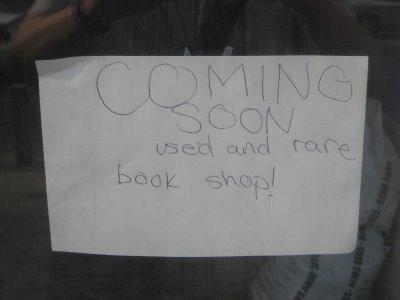HTMLGIANT Wants To Know:
Do you have any weird food/eating/drinking habits?

Sometimes I like to put ice in my glass of milk.
Publishing Metaphors: Richard Nash’s Round Table
 Via David Nygren, I read an article in Publishers Weekly that reported on Richard Nash and Dedi Felman’s panel at this year’s Book Expo. During the panel, titled “The Concierge and the Bouncer,” Nash and Felman describe their plans for a new publishing model/site, I suppose, that follows the metaphor of a round table, across which editors, readers, authors, business people, and others share their ideas about publishing and literature and so on (the traditional publishing metaphor being, perhaps, *a laundry chute?).
Via David Nygren, I read an article in Publishers Weekly that reported on Richard Nash and Dedi Felman’s panel at this year’s Book Expo. During the panel, titled “The Concierge and the Bouncer,” Nash and Felman describe their plans for a new publishing model/site, I suppose, that follows the metaphor of a round table, across which editors, readers, authors, business people, and others share their ideas about publishing and literature and so on (the traditional publishing metaphor being, perhaps, *a laundry chute?).
Nash and Felman outlined their push back against the outmoded idea of publisher as cultural gatekeeper. Nash didn’t realize until after he left Soft Skull, where he was “locked into this lefty, punky, quasi-anarchist, multi-interned model,” that it was the dreaded slush pile—not the publisher-author-reader hierarchy—that kept the business alive: “you have to keep accepting unsolicited submissions, because those people are our readers.” The key is a shift from a caretaker mentality to a service mentality, from a linear supply-chain model to the idea of a free-floating, non-hierarchical “ecosystem” of readers, writers and authors.
Felman outlined the concept in more detail: using a subscription system, Round Table will bring to the social networking platform not just finished content, but many aspects of the publishing process—including, for authors open to the idea, peer editing. The idea is that feedback and crowd-sourcing can dramatically enrich the editing, authoring and reading process for all involved—not to mention expose potential talent among members of the community (“In our formulation,” says Nash, “readers are writers”).
Over at his blog, Nash says that he’s been busily resarching and preparing for BEA, which is going on now, but plans to post during June some essays and so on that will hopefully explain in more detail this project.
*if you have a better metaphor for how traditional publishing works…
Word Spaces (12): Amelia Gray
Amelia Gray is the author of AM/PM (featherproof) and Museum of the Weird (forthcoming from FC2). She recently won the FC2 Fiction Prize. I’ve linked to a page on her website that lists many publications online that you may read over. Also, here’s an audio recording of Amelia’s reading from AM/PM in Tucson for a reading thing at Congress, I think.
Various information about her and her work can be read here:
AM/PM reviewed at Literary License
Amelia Gray’s favorite novellas
Below is her word space. Enjoy.
drunk post: does anyone want Logan’s Run on DVD?
 So it’s been an uneventful Memorial Weekend Sunday of drinking and doing laundry here in Houston. I finally got around to watching Logan’s Run, a sci-fi film based on the novel of the same name by William F. Nolan and George Clayton Johnson. I’ve owned this movie for a few years, but never got around to watching it.
So it’s been an uneventful Memorial Weekend Sunday of drinking and doing laundry here in Houston. I finally got around to watching Logan’s Run, a sci-fi film based on the novel of the same name by William F. Nolan and George Clayton Johnson. I’ve owned this movie for a few years, but never got around to watching it.
Until now.
Used Bookstore Finds: ‘This pen is gorgeous!’

After the previous used bookstore finds post, Aaron Gilbreath emailed me to say that he was currently working on a project based on the many objects he had discovered during his time working at Powell’s Books in Portland. He offered to share a few of those objects with HTMLGIANT, and I told him to send in whatever he wanted. After the break are three found objects and the entries he has written about them:
Word Spaces (11): Lily Hoang
Lily Hoang is the author of Parabola (Chiasmus Press) and Changing (Fairy Tale Review Press) and has an ebook at Lamination Colony titled The Woman Down the Hall. She is an associate editor at Starcherone Books.
Lily Hoang once visited Houston. She was impressed with Houston’s public transportation, which is basically a light rail train that travels up and down a few blocks, but costs lots of money to maintain. She gave a reading at UH-Downtown and then shared a cigarette with Gene Morgan at Poison Girl.
After the jump: Lily’s Word Space.
A Public Space Giveaway

a pubic space
I have issues 02 through 06 of A Public Space to give to someone. They are not fitting on my shelf right now and I don’t want to move them in a box to a new place this summer. I would like to give them to someone.
Issues 02-06 include an essay on Chicago by Peter Orner, a photo essay that documents bathroom graffiti at Camp Ali Al Salem in Kuwait, a special focus on Antarctica, and assorted fiction/poetry.
If you wish to be eligible for this free gift, please email your name and mailing address to htmlgiant [at] gmail [dot] com by noon cst this Sunday. The random integer generator will then be unleashed upon the emails and a winner will be chosen and so on.
I just park the cars, ma’m
In my search for a suitable image to place at the head of next week’s A Public Space giveaway post (issues 2-6, so look out for that), I discovered this video at Urban Prankster, which documents a project in 1994 that several artists organized at Southwestern College in Chula Vista.
On August 31, 1994 from 6am to noon, a team of 50 professional and volunteer parking attendants directed the arriving cars to predetermined lots according to car color. Each of the fourteen lots was filled with cars of a different color: dark blue, blue, light metallic blue, silver & gray, black, beige, brown, metallic raspberry, yellow, electric blue, white, aqua, green and red
Basically, they color-coded all the parking lots and had people park their cars according to some chart or something. It reminded me of Chris Cobb’s project in Adobe Books, but instead, like, with cars and lots of people and orange traffic vests and awkward interviews.
My favorite part of the video might be at 2:29, though some of the other things people say about the project are pretty funny. I can’t get the video to embed, so just click the link below.
Houston Indie Book Festival: A Review by Kirby Johnson
 I missed my chance to attend last weekend’s Houston Indie Book Festival because I was caught up in various Mother’s Day events; however, I was able to get in touch, through Signe Cluiss, with Kirby Johnson, cofounder/coeditor of NANO Fiction and one of the organizers of the festival. I asked her if she would write some of her thoughts about the day, and after the break I’ve posted what she kindly sent back.
I missed my chance to attend last weekend’s Houston Indie Book Festival because I was caught up in various Mother’s Day events; however, I was able to get in touch, through Signe Cluiss, with Kirby Johnson, cofounder/coeditor of NANO Fiction and one of the organizers of the festival. I asked her if she would write some of her thoughts about the day, and after the break I’ve posted what she kindly sent back.
May 15th, 2009 / 12:59 pm
The Rumpus on Shane Jones and Stanley Crawford
 Justin Dobbs tipped us off that The Rumpus had published last week a nice review of Shane Jones’ Light Boxes. Jovanovic writes:
Justin Dobbs tipped us off that The Rumpus had published last week a nice review of Shane Jones’ Light Boxes. Jovanovic writes:
Jones makes use of ambiguity and possibility in the fabulist tradition of Gabriel García Márquez, but Light Boxes should not be considered a magic-realist novel. The sidereal reality of Thaddeus and The Solution is not simply one where magical elements are introduced into ordinary settings, like the man vomiting rabbits into flowerpots in Julio Cortázar’s “Letter to a Young Lady in Paris” (though Thaddeus does vomit ice cubes)—in Jones’s novel there are few touchstones to the world as we know it. Light Boxes partakes in the traditions of folklore, archetypal myth, and oral history, a pedigree reflected in its images and descriptions. Clouds have legs and shoulders. They are shaped like a hand and can fall apart like wet paper.
Dobbs’ email reminds me that I need to read The Rumpus more, because likely I’ll find good stuff over there, such as this blog post by Deb Olin Unferth on Stanley Crawford’s The Log of the S.S. the Mrs. Unguentine.
If I had to make a small, partial statement here about book reviewing, I’d say this: I find that the most effective reviews (those that affect me most, I mean) tend to be the reviews that make me remember how much I enjoyed reading a certain book (for some reason, I rarely read reviews of books I haven’t yet read?). And I’m using ‘reviews’ here in the loosest sense. Jovanovic’s review and Unferth’s blog post both do this. I enjoy reading another’s telling of his or her experience of a book and I enjoy the connections that telling ignites in my head.
Is this a stupidly simple appreciation of book reviews? Probably.
May 14th, 2009 / 11:14 am
